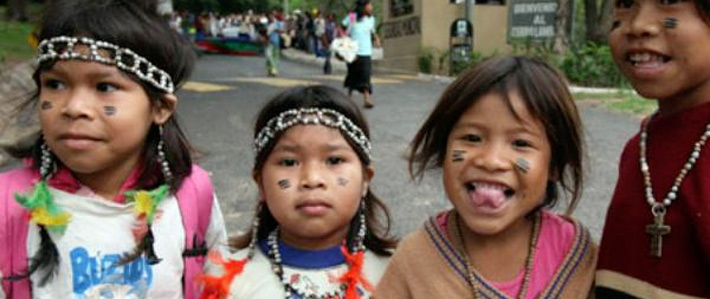
The GM soy-exporting model is particularly threatening indigenous peoples’ cultures and survival, said the UN special rapporteur
EXCERPT: This agricultural development model has displaced many rural communities from their lands. Many farmers were offered money in exchange for their land, which some would accept to live in the cities. However, many would realize that the money, coupled with the lack of sustainable employment opportunities in the city, didn't go very far, resulting in a swelling of the urban poor. In other cases, entire families and communities would have to leave their land because of deforestation caused by soy farms, or the fumigation of the soy crops, which poisoned not only their own crops, but also local water supplies and the environment in general.
UN: Industrial agriculture endangering indigenous right to land
Telesur, 28 Nov 2014
http://www.telesurtv.net/english/news/UN-Industrial-Agriculture-Endangering-Indigenous-Right-to-Land-20141128-0031.html
The soy-exporting model is particularly threatening indigenous peoples’ cultures and survival, said the UN special rapporteur.
Over 40 percent of indigenous communities of Paraguay have no access to land, while those who do suffer from the invasions by ranchers and soy-producers, said a United Nations official Friday.
Victoria Tauli Corpuz, the U.N. special rapporteur for the rights of indigenous peoples, spent a one week visit in the South American country.
“Almost half of the indigenous communities informed me that they lacked land and even when they have property titles, the security of owning land is not guaranteed,” said Tauli Corpuz to journalists in Asuncion, the Paraguayan capital.
She mentioned the case of the only original people from Paraguay, called Ayoreo Totobiegosode, which includes uncontacted members. Their representatives repeatedly denounced the illegal wood cutting taking place on their ancestral lands.
“People who have always lived in forests must have forests in order to maintain their culture and religion,” affirmed the U.N. representative. The exceptional and recent economic growth of the country is occurring at the expense of the woods and rivers, crucial for the food security of indigenous peoples, she argued.
Moreover, she added that the effects of climate change, such as severe droughts and floods, are making the production of the necessary food for subsistence living even more difficult.
While indigenous people represent just two percent of the total population of Paraguay, their poverty rate is at 63 percent – three times higher than the national average.
Context
Paraguay has one of the worst rates of unequal land distribution in the region, which especially affects small farmers and indigenous communities. The rates were inherited from the 19th century, and got worse under the dictatorship of General Alfredo Stroessner, which last between 1954-1989. In this period, a lot of land that belonged to the state was given to relatives, friends, and political and military allies. Those lands are the source of many conflicts today, as they are legally eligible for land reform.
Small and medium-scale farmers, whose agriculture helped feed the country, were gradually pushed off their lands because of the new agricultural export model introduced in the 1970s, along with industrialization and the introduction of soy as a cash crop.
In 1996, biotechnology agricultural company Monsanto introduced a genetically modified soy seed to neighboring Argentina. This spread quickly through the Southern Cone, before formally becoming legalized in Paraguay in 2004, although it was present in the country beforehand.
This agricultural development model has displaced many rural communities from their lands. Many farmers were offered money in exchange for their land, which some would accept to live in the cities. However, many would realize that the money, coupled with the lack of sustainable employment opportunities in the city, didn't go very far, resulting in a swelling of the urban poor. In other cases, entire families and communities would have to leave their land because of deforestation caused by soy farms, or the fumigation of the soy crops, which poisoned not only their own crops, but also local water supplies and the environment in general.
In 1993, about 1.5 million hectares of soy crops were cultivated; in 2014, this number reached 3.1 million hectares. Paraguay has become the world’s fourth largest exporter of soy, most of it to feed cattle or produce bio-fuel. Meanwhile, agribusiness companies, exempted from taxes, contribute very little to the national wealth, despite soaring profits.
Paraguayan farmers and indigenous communities are not only suffering from one of the most unequal distributions of land, but also from the invasion of one of the worst agricultural models: soy exportation, mechanized agriculture, and genetically modified seeds all combined together.









